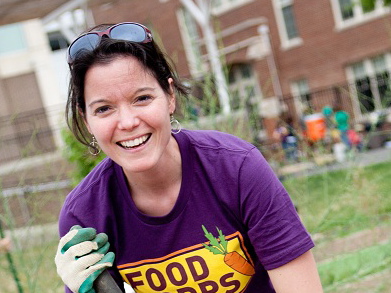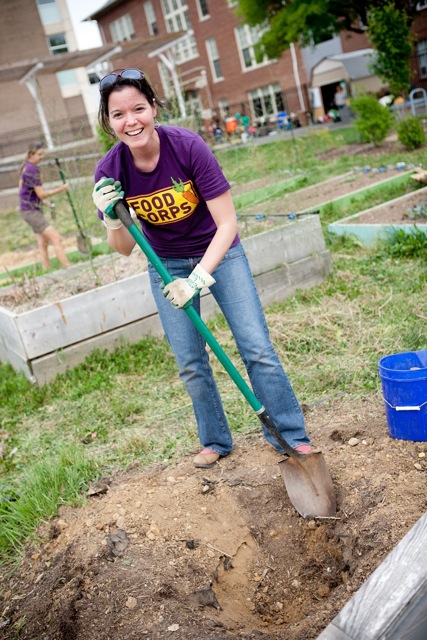
reference-image, l
(article, Jackie Varriano)
[%pageBreakSettings nobreak=true] p(blue). Debra Eschmeyer grew up on a dairy farm in rural Ohio, where she learned at a young age that there isn’t always such a thing as a “weekend.” As an adult, she’s farming once again, but this time, instead of milking cows, she’s harvesting fruit, vegetables, and flowers. p(blue). However, running Harvest Sun Farm with her husband, Jeff, is only Eschmeyer’s part-time job. Before she came full circle, Eschmeyer worked for the National Farm to School Network, was an editor for Food Justice (a 2010 book by Robert Gottlieb and Anupama Joshi), and was a Kellogg Food & Community Fellow, where her efforts working on school-food reform earned her a James Beard Foundation Leadership Award. p(blue). Now her days are spent as the director of policy and partnerships for FoodCorps, a position that cements her status as an expert in national food systems and policy. The organization, of which Eschmeyer is a co-founder, is part of the AmeriCorps service network. It's the inspirational result to a question — “What could America look like 50 years from now if we started a Peace Corps for school food?” — posed by the founding members in 2011, on the 50th anniversary of the Peace Corps. p(blue). Now accepting applications for 130 positions in 15 states, FoodCorps places service members in schools and communities across the country. The members teach kids about healthy food and where it comes from, build and tend school gardens, and bring high-quality local food into public-school cafeterias. Did your childhood prepare you for FoodCorps and your job now? Indeed! I grew up in New Knoxville, Shelby County, Ohio, in a town of 891, that I currently also reside in. And it’s definitely helped shape my understanding and appreciation for agriculture, specifically the need to restore the connection between food, community, land, and place. I have a deep respect for farmers and I really want all children, and all society, to know who their farmer is, just like your doctor. And that not only because it’s valuable to put a face to who grows your food, but in showcasing farmers and public-health leaders that food is the gateway to health. So now you’re a farmer again. Yes, I am. Dairy farming is really different than fruit and vegetable farming. My husband and I mortgaged the fifth-generation family farm on his side of the family back in 2007, and we’ve been slowly building the farm since. Now we have 22 acres certified organic for fruit and vegetable production. We were selling to farmers' markets and grocery stores while we were both working full time. But in 2010, my husband went full time on the farm, and we started a CSA. We had 35 CSA members last year, and this year we aim to have 70. We hope to continue doubling our CSA membership until we’re at a point where we’re economically viable. I’m obviously still working full time for FoodCorps, which of course I love. So what does your day look like now? I think this is actually goes back to being a dairy farmer’s daughter, where I don’t have the exact same sense of an average work day, but I love the balance. Right now is actually a really healthy balance time, because the farm is still covered in snow in Ohio. Our full production is really from June to October. In the summer, I wake up early, between 5:30 and 6, and I’ll work a couple hours outside until about 8 or 8:30, and then I’ll work on FoodCorps until 6. Then I go back outside and work out there until it's dark, and then I come back inside and work on whatever I wasn’t able to finish during work hours. And that repeats itself every day. I truly love the balance of getting up in the morning and harvesting the lettuce that’s going to be picked up by the CSA later in the afternoon, processing and putting it in the cold box, and cutting my flowers for the flower share and making my bouquets late at night. I swear that’s my favorite thing. My husband hates it, but I absolutely love it. I harvest late at night, and then I do all the bunching in our barn. It’s just a delightful thing to do at 11 at night and you’ve had a long day and you have these beautiful flowers in front of you to put together. You can’t really call that work. Switching gears, when do you think the school food reform movement started? I think it’s been a process. The national school-lunch program began in 1946 as a response to hunger. It was something where our school kids were nutritionally deficient, and it was started mainly for national-security reasons; our children needed the access to additional calories. Now we have the reverse situation, where we have children who are not getting good proper calories. We’re actually in a situation where the same child is experiencing obesity and malnutrition, and it’s definitely a quandary, because it comes down to the calories that are being consumed. It’s been a process of the same thing that we see in our culture of the way that we’ve treated food as a convenience item instead of an educational tool, or a cultural item, or a way to have a healthy life. I remember the controversy over Congress supposedly declaring pizza a vegetable in 2011. Do you think we’ve moved forward from that? Have things gotten better? I think we’re striving to improve, and I think things have actually gotten better, especially in the last four or five years. [%image shovel float=right width=400 caption="Debra Eschmeyer"] The Healthy Hunger-Free Kids Act passed in 2010. And the Farm to School Competitive Grants Program was instituted, which makes five million dollars mandatory in Farm to School grants every year to help schools start the Farm to School program for their community. There’s been a lot of excitement for changing the school-food environment. Back in 1997, there were only about three Farm to School programs nationwide, and now there are Farm to School programs in every single state and they’re growing across the country. There are 33 states that have Farm to School policy in place. There’s full-time Farm to School coordinators in the Department of Education, the Department of Health, the Department of Ag on a statewide level. And there’s even a USDA Farm to School program team, which is revolutionary. How about FoodCorps? Is it still in the beginning stages, or have you moved past that? That’s a good question. We’ve been building for quite some time, and there’s great demand out there from communities who need us. At the same time, there’s great demand to serve. We currently have 92 \[people\] in the field in 250 schools in 12 states, and we hope to grow to over 1,000 serving in all 50 states by 2020. At the same time, we have over 1,000 applying to serve every year, so there’s just this intense demand to serve and be part of improving the school-food environment. School lunch is one of the most regulated and complex meals in the world, and if we can change the school-food environment for the better, we can change anything. What FoodCorps brings to the picture is national coordination and large-scale visibility with federal and philanthropic partnerships. And because we are a part of the AmeriCorps service network, we believe that everyone should be a part of the solution. Citizens need to be a part of it, to be in the middle of the solution. We invest in human capital and community relations to get the job done, and our goal is that we aren’t any longer needed in the schools. We want FoodCorps to be in the community as long as we’re needed, and then move on to another location that needs us. There are over 100,000 public schools in the United States, and we know that the challenge is there, but FoodCorps isn’t created just to exist. We’ve been created to accept the challenge. And as we grow, we’re growing leaders and hoping that they’ll build within their community so that we can move on to where we’re needed next. Your service members from the first year — are any of them still involved, or have they moved on? In August 2012, we graduated our first class of service members, and more than half of them decided to return for a second year of service with us, which is really exciting. We also started a second tier of leadership in our Corps called the FoodCorps Fellows. In that role, the fellow is a statewide lead supporting the fellows in their state. You had to be an existing member for a year to be a fellow, and that’s a way for us to continue building leadership within the Corps. For those that continued on outside of FoodCorps, it’s really been beautiful and fun to watch them flourish. One service member, for example, was serving in Iowa; her name is Leah Chapman. She moved to Florida, where she now works for Aramark, a food service management company. She accepted a position as their sustainability manager for the dining services for the University of Florida — which is really perfect, and that’s exactly what we want to happen. We want the graduates of our program, the alumni, to become dedicated to the food system and improving it across the country. We also have a really awesome service member in Arizona with the Tohono O’odham Community Action. Her name is Stephanie Lip and she was hired to join the TOCA staff as the Food Services Development Director, so her job is to actually analyze existing school-food systems and implement scratch cooking and meal programs for the Tohono O’odham nation, which is just so exciting. And of course, I hope we’ll get a future senator or president out of the FoodCorps alumni. And they’ll all farm while doing their other jobs. What can members of the community do to contribute to FoodCorps? There’s many different ways that the community contributes, because they’re the essence of how this all works and operates. Our entire program is based on a partnership model; we have statewide partners that we select as "host sites," and they help select our “service site,” which is a community of high need. There are schools and nonprofits that we work with to focus our energy, and through those community partners, people can volunteer at school gardens, in the classroom, in helping harvest. There are many different elements. Such a huge piece of what we do is creating avenues for community members to get involved in the school-food environment and really take ownership over the success and understand the elements of investing in the kids, their future, and their health. Our service members aren’t just coming in and making all the decisions; they’re doing it as a team, and it’s completely a community-based effort. p(bio). Jackie Varriano is a writer based in Eugene, Oregon. Keep up with her at SeeJackWrite.

reference-image, l

shovel, l